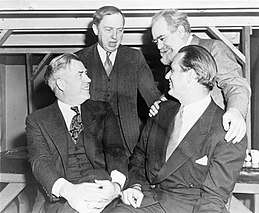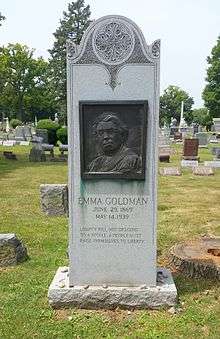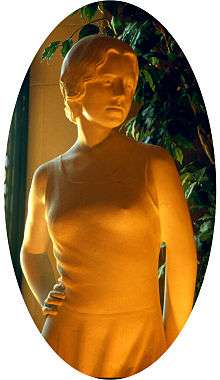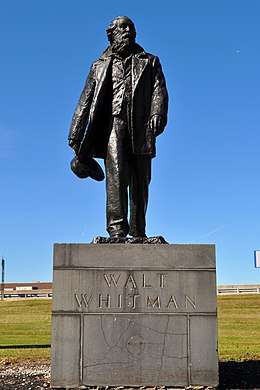Jo Davidson
Jo Davidson (March 30, 1883 – January 2, 1952) was an American sculptor. Although he specialized in realistic, intense portrait busts, Davidson did not require his subjects to formally pose for him; rather, he observed and spoke with them. He worked primarily with clay, while the final products were typically cast in terra-cotta or bronze, or carved from marble.
.jpg)
Background

Davidson was born in New York City, where he was educated before going to work in the atelier of American sculptor Hermon Atkins MacNeil. He subsequently moved to Paris in 1907 to study sculpture at the Ecole des Beaux-Arts.
Career
Art
After returning to the United States, he was befriended by Gertrude Vanderbilt Whitney, who purchased some of his work.
In 1911 Davidson secured his first solo gallery shows. In 1927 he was one of a dozen sculptors invited by the oilman E. W. Marland to compete for a commission for a Pioneer Woman statue in Ponca City.[1] Each was paid a commission to produce a small model, and the dozen works were exhibited in major cities in the US. Davidson did not win the commission.
In 1934 Davidson won the National Academy of Design's Maynard Prize. In 1944, he was elected into the National Academy of Design as an Associate Academician. In 1947 the American Academy of Arts and Letters hosted a retrospective featuring nearly 200 of his works. In the summer of 1949, Davidson was one of 250 sculptors who exhibited in the 3rd Sculpture International held at the Philadelphia Museum of Art.
Among Davidson's commissions are a design for a United States War Industries badge, a collection of pieces for the Government of France to commemorate the first victory of the Troupes de Marine, and bronze busts of the leaders of the First World War Allies.[2] His portraits of world leaders and celebrated figures gained him international acclaim. He created statues of oilman and future governor E. W. Marland and his two adoptive grown children.
Politics


Davidson served as chairman of the Independent Citizens Committee of the Arts, Sciences and Professions (ICCASP), a leftist-liberal group that supported the policies of President Franklin D. Roosevelt and his re-election. In 1946 this group merged with the National Citizens Political Action Committee (NCPAC) to become the Progressive Citizens of America (PCA); Davidson became co-chairman (the other chairman being Dr. Frank Kingdon).
PCA struggled during tensions of the Cold War, with its members under suspicion by the House Un-American Activities Committee (HUAC) for leftist leanings. It worked for racial equality, economic justice and civil liberties. Important segments of the PCA became the base for Henry A. Wallace's candidacy for U.S. President in 1948 on the Progressive Party ticket.
Commissions

- Manuel Azaña
- Julio Álvarez del Vayo
- James Barrie
- Nicholas Murray Butler
- Charlie Chaplin
- Madame Chiang Kai-shek
- Joseph Conrad
- Émile Coué (who was also a sculptor in his spare time)
- Clarence Darrow
- Charles G. Dawes - bust, part of the United States Senate Vice Presidential Bust Collection
- Arthur Conan Doyle
- Albert Einstein
- Dwight D. Eisenhower
- Marshal Ferdinand Foch
- Anatole France
- Mahatma Gandhi
- André Gide
- Emma Goldman
- W. Averell Harriman
- Frank Harris
- Dolores Ibárruri (La Pasionaria)
- Robinson Jeffers
- James Joyce
- Otto Kahn[3]
- Helen Keller
- Rudyard Kipling
- Robert M. La Follette, Wisconsin contribution to National Statuary Hall, United States Capitol
- D. H. Lawrence
- Edward Drummond Libbey, founder of the Libbey Glass Company and the Toledo Museum of Art in Toledo, Ohio
- Henry Luce
- John Marin
- E. W. Marland
- Lydie Marland and her brother George Roberts Marland
- Lowell Mellett
- Andrew Mellon
- Constancia de la Mora
- General John J. Pershing
- John D. Rockefeller
- Will Rogers (posthumous) - the original statue donated to the Will Rogers Memorial Hospital in Saranac Lake, New York
- Will Rogers (posthumous) - bronze, Oklahoma contribution to National Statuary Hall, United States Capitol, erected in 1939
- Franklin Delano Roosevelt installed at the Franklin D. Roosevelt Four Freedoms Park
- Ida Rubinstein
- Carl Sandburg
- E. W. Scripps
- George Bernard Shaw
- Lincoln Steffens
- Gertrude Stein
- Rabindranath Tagore
- Marshal Tito[4]
- Getúlio Vargas
- H. G. Wells
- Henry A. Wallace - bust, part of the United States Senate Vice Presidential Bust Collection
- Walt Whitman (posthumous) - full-body bronze statue at the Walt Whitman Bridge in Philadelphia, and in Bear Mountain State Park, New York.
- Gertrude Vanderbilt Whitney
- Walt Whitman statue
- Evan Williams (Opera tenor)
- Woodrow Wilson
- Israel Zangwill
Collections
Some of Davidson's work is in the National Gallery of Art.
He also designed a statue of Henry D. Thoreau, the author of the book Walden. The statue is located at Walden Pond State Reservation in Concord, Massachusetts.
In 2006, The Smithsonian Institution's National Portrait Gallery opened a permanent exhibition, "Jo Davidson: Biographer in Bronze", showcasing fourteen Davidson works in terracotta and bronze, including portraits of Gertrude Stein and Lincoln Steffens.
References
- ’Exhibition of Models for a Monument to the Pioneer Woman, Art Institute of Chicago, June 25 to August 1, 1927
- Davidson. Jo, ‘’Between Sittings: An Informal Autobiography of Jo Davidson’’, The Dial Press, NY : 1951, p. 134
- The Smithsonian Institution, National Portrait Gallery, has the Otto Kahn bust by Jo Davidson:https://npg.si.edu/object/npg_NPG.68.44
- Prijem američkog vajara Džo Dejvidsona i poziranje. foto.mij.rs
Sources
- Armstrong, Craven et al., 220 Years of American Sculpture, Whitney Museum of Art & David R. Goodine, Publisher, NY 1976
- Compilation of Works of Art and Other Objects in the United States Capitol, Prepared by the Architect of the Capitol under the Direction of the Joint Committee on the Library, United States Government Printing Office, Washington D.C. 1965
- Connor, Janis and Joel Rosenkranz, photographs by David Finn, Rediscoveries in American Sculpture: Studio Works, 1893 - 1939, University of Texas Press, Austin TX 1989
- Craven, Wayne, Sculpture in America: From the Colonial Period to the Present, Thomas Y, Crowell Company, NY 1968
- Davidson, Jo, Between Sittings: an informal autobiography, The Dial Press, NY 1951
- Griffin, Henry F. (August 1911). "Jo Davison, Sculptor: The Striking Work Of A Man Who Loves His Art More Than He Loves "Success"". The World's Work: A History of Our Time. XXII: 14746–14755. Retrieved 2009-07-10.
- Homepage of the National Portrait Gallery, Washington, DC: Permanent Exhibitions.
| Wikimedia Commons has media related to Jo Davidson. |


